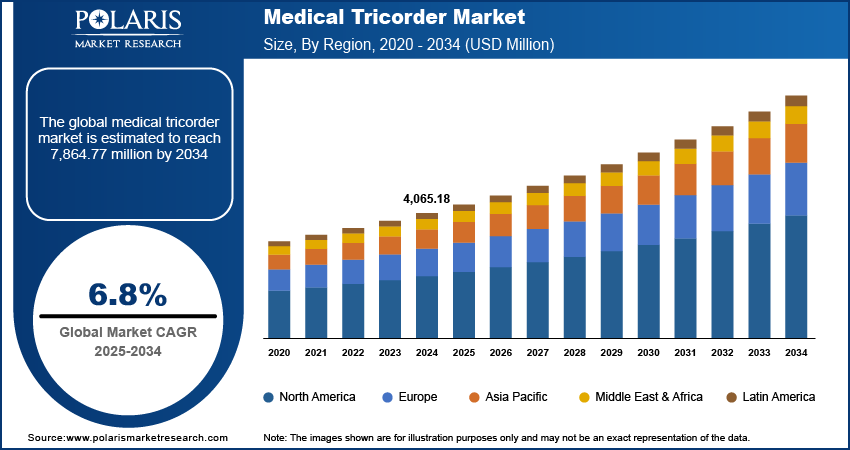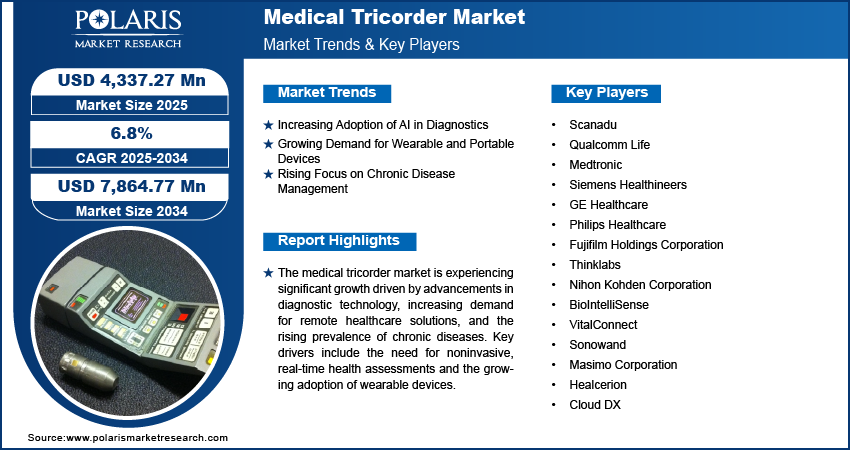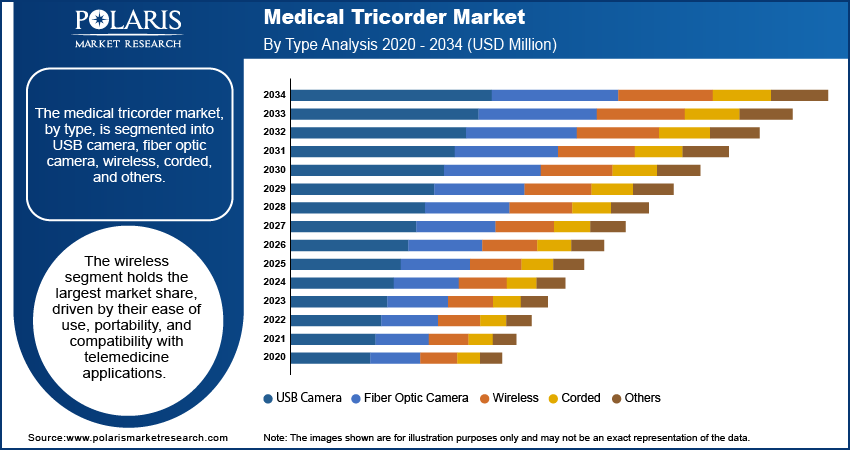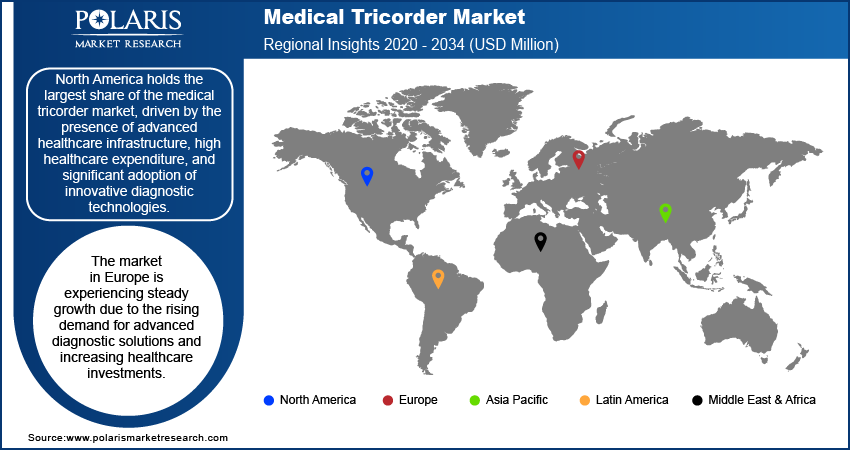
Medical Tricorder Market Size, Share, Trends, Industry Analysis Report
: By Type (USB Camera, Fiber Optic Camera, Wireless, Corded, and Others), Application, End Users, and Region (North America, Europe, Asia Pacific, Latin America, and Middle East & Africa) – Market Forecast, 2025–2034
- Published Date:Aug-2025
- Pages: 119
- Format: PDF
- Report ID: PM1735
- Base Year: 2024
- Historical Data: 2020-2023
Market Overview
The global medical tricorder market size was valued at USD 4,065.18 million in 2024, growing at a CAGR of 6.8% during 2025–2034. Advancements in sensor technology, AI integration for accurate diagnostics, growing demand for remote healthcare solutions, wearable devices, and increasing focus on chronic disease management and personalized medicine drive the market.
Key Insights
- The wireless segment holds the largest share due to its portability, ease of use, and integration with telemedicine, enhancing chronic disease management.
- The diagnosis segment dominates the market, driven by the need for accurate, noninvasive diagnostic tools in clinical and home care settings.
- The hospitals segment holds the largest market share, benefiting from high patient inflow, the need for efficient diagnostics, and integration with hospital systems.
- North America holds the largest share, driven by advanced healthcare infrastructure, high healthcare expenditure, and significant adoption of innovative diagnostic technologies.
- Europe is experiencing steady growth, supported by strong healthcare systems, increasing demand for advanced diagnostics, and regulatory initiatives promoting portable tools.
Industry Dynamics
- AI enhances diagnostic accuracy, streamlines workflows, and improves patient outcomes, driving demand for more advanced medical tricorders.
- Wearable devices cater to the increasing interest in preventive healthcare, offering continuous health monitoring for chronic conditions and telemedicine.
- The rising prevalence of chronic diseases drives the demand for accessible, real-time monitoring tools such as medical tricorders in home settings.
- High initial costs and regulatory hurdles may delay broader adoption of AI-powered medical tricorders in healthcare systems.
Market Statistics
2024 Market Size: USD 4,065.18 million
2034 Projected Market Size: USD 7,864.77 million
CAGR (2025–2034): 6.8%
North America: Largest market in 2024
AI Impact on Medical Tricorder Market
- AI integration in medical tricorders enhances diagnostic accuracy, enabling faster and more precise health assessments in remote healthcare settings.
- AI algorithms process complex data from sensors and imaging results, reducing diagnostic errors and improving overall patient outcomes.
- The use of AI-powered tools in medical tricorders aids early disease detection, which is essential for managing chronic conditions effectively.
- AI in medical tricorders streamlines workflows for healthcare professionals, reducing their workload while improving diagnostic speed and efficiency.

To Understand More About this Research: Request a Free Sample Report
The global medical tricorder market encompasses the development, production, and adoption of portable diagnostic devices that enable rapid health assessments and monitoring of vital signs. These devices are designed to provide noninvasive or minimally invasive diagnostics, making them highly valuable in point-of-care and remote healthcare settings. A few key drivers of the market growth are advancements in sensor technology, increasing demand for remote healthcare solutions, and a growing focus on personalized medicine. Medical tricorder market trends include the integration of artificial intelligence (AI) for improved diagnostic accuracy, rising investments in wearable healthcare technology, and expanding applications in chronic disease management. The market is also influenced by the rising prevalence of lifestyle-related disorders and the need for cost-effective healthcare solutions.
Market Dynamics
Increasing Adoption of AI in Diagnostics
The integration of artificial intelligence (AI) into medical tricorders is transforming diagnostic capabilities by enhancing speed and accuracy. AI-powered algorithms analyze complex datasets, such as imaging results and biosensor readings, to provide precise diagnostic insights. For instance, AI applications have demonstrated a diagnostic accuracy rate of over 90% in certain medical conditions, such as respiratory and cardiovascular diseases. This trend is driven by the need for early detection of illnesses and reducing the burden on healthcare professionals. According to a 2023 study by the National Institutes of Health (NIH), AI-enabled tools significantly reduce diagnostic errors, improving patient outcomes and streamlining workflows. Thus, the rising adoption of AI in diagnostics drives the medical tricorder market development.
Growing Demand for Wearable and Portable Devices
The demand for wearable and portable medical devices has upsurged, contributing to the evolution of medical tricorders. These devices enable continuous monitoring of parameters such as heart rate, blood pressure, and blood glucose, catering to the growing interest in preventive healthcare. For example, a report from the World Health Organization (WHO) highlights that 70% of adults are willing to use wearable devices for health monitoring. This trend aligns with the shift toward patient-centric care models, where users actively participate in managing their health. The portability of medical tricorders further enhances their adoption, particularly in home healthcare and telemedicine.
Rising Focus on Chronic Disease Management
Medical tricorders are increasingly utilized in the management of chronic conditions, such as diabetes, hypertension, and chronic obstructive pulmonary disease (COPD). With chronic diseases accounting for 74% of global deaths, as per WHO data from 2022, there is a heightened emphasis on innovative diagnostic solutions. Medical tricorders enable real-time monitoring and early intervention, reducing hospital visits and associated costs. For example, continuous glucose monitors integrated into tricorders provide accurate readings and insights for diabetes patients, improving disease management and compliance with treatment plans. This trend reflects the growing demand for accessible and efficient tools, such as medical tricorder, to address long-term health conditions.

Segment Insights
Market Outlook – Type-Based Insights
The medical tricorder market, by type, is segmented into USB cameras, fiber optic cameras, wireless, corded, and others. The wireless segment holds the largest market share, driven by their ease of use, portability, and compatibility with telemedicine applications. These devices enable seamless real-time monitoring and data transfer, which is increasingly vital in remote healthcare settings. The growing reliance on wireless technologies for chronic disease management and the increasing adoption of connected healthcare solutions are key factors supporting this segment's dominance. Furthermore, advancements in wireless communication protocols and the integration of AI enhance diagnostic accuracy, fueling their widespread adoption.
The fiber optic camera segment is anticipated to register the highest growth rate during the forecast period due to its superior imaging capabilities and precision diagnostics. These devices are particularly valuable in endoscopic procedures and minimally invasive surgeries, where high-resolution imaging is critical. The rising demand for improved diagnostic tools in surgical and outpatient settings is driving the uptake of fiber optic cameras. Additionally, the healthcare industry’s focus on reducing procedural complications and improving patient outcomes aligns with the adoption of fiber optic technology, further propelling this segment's growth trajectory.
Market Assessment – Application-Based Insights
By application, the medical tricorder market is segmented into diagnosis, monitoring, and others. The diagnosis segment holds the largest market share, primarily due to the increasing need for accurate, noninvasive diagnostic tools in clinical and homecare settings. These devices are widely used for detecting a range of medical conditions, including respiratory diseases, cardiovascular disorders, and infections. The rising prevalence of chronic diseases and the growing emphasis on early disease detection are key factors contributing to the dominance of this segment. Additionally, advancements in diagnostic sensors and algorithms integrated into tricorders enhance their reliability and effectiveness, supporting their widespread adoption.
The monitoring segment is expected to register the highest growth rate, driven by the growing demand for real-time health data in managing chronic illnesses such as diabetes, hypertension, and cardiac conditions. Monitoring applications leverage continuous data collection and analysis, enabling proactive healthcare and reducing the frequency of hospital visits. The increasing integration of remote monitoring solutions into telemedicine platforms is further propelling this segment’s growth. As healthcare shifts toward a more preventive and patient-centric approach, the adoption of monitoring-enabled medical tricorders is anticipated to expand significantly in the coming years.
Market Evaluation – End User-Based Insights
In terms of end users, the medical tricorder market is segmented into hospitals, clinics, and others. The hospitals segment holds the largest market share due to their extensive utilization of advanced diagnostic and monitoring tools in diverse medical scenarios, including emergency care, inpatient services, and specialized departments. The demand for efficient and accurate diagnostic devices in hospitals is fueled by the high patient inflow and the need to address a wide range of medical conditions promptly. Additionally, the integration of medical tricorders with hospital information systems enhances workflow efficiency, further solidifying the segment’s prominence in the market.
The clinics segment is expected to register the highest growth rate, driven by the increasing adoption of portable diagnostic tools to provide enhanced patient care in outpatient and primary care settings. Medical tricorders enable clinics to offer comprehensive health assessments, reducing dependency on external laboratories and improving patient turnaround times. The rise in point-of-care diagnostics and the growing focus on preventive healthcare are key factors driving the growth of this segment. Furthermore, the affordability and portability of tricorders make them an attractive solution for clinics seeking cost-effective ways to expand their diagnostic capabilities.

Regional Insights
By region, the study provides medical tricorder market insights into North America, Europe, Asia Pacific, Latin America, and the Middle East & Africa. North America holds the largest share of the market, driven by the presence of advanced healthcare infrastructure, high healthcare expenditure, and significant adoption of innovative diagnostic technologies. The region benefits from strong investments in research and development, particularly in the US, which is a hub for medical technology innovation. Additionally, the rising prevalence of chronic diseases and the growing demand for remote healthcare solutions boost market growth in North America. Favorable regulatory policies and increasing awareness about portable diagnostic tools among healthcare providers also contribute to the region's dominance. Other regions, such as Europe and Asia Pacific, are experiencing steady growth due to advancements in healthcare systems and increasing demand for point-of-care diagnostics.
The medical tricorder market in Europe is experiencing steady growth due to the rising demand for advanced diagnostic solutions and increasing healthcare investments. Countries such as Germany, the UK, and France are at the forefront, driven by well-established healthcare infrastructure and high adoption rates of innovative technologies. The region's focus on addressing chronic disease management and enhancing preventive care further supports market expansion. Additionally, regulatory initiatives promoting the use of portable diagnostic tools and an aging population with growing healthcare needs are key factors contributing to the market growth in Europe.
The Asia Pacific medical tricorder market is witnessing significant growth, fueled by rapidly expanding healthcare infrastructure and increasing investments in medical technology. Countries such as China, Japan, and India are leading this growth, supported by rising healthcare awareness and government initiatives to improve access to advanced diagnostic tools. The growing prevalence of chronic diseases and a large population base seeking cost-effective healthcare solutions are major drivers. Furthermore, advancements in telemedicine and remote monitoring technologies are boosting the adoption of medical tricorders across the region.

Key Players and Competitive Insights
The medical tricorder market features several key players actively developing and innovating diagnostic and monitoring technologies. A few notable companies are Scanadu, Qualcomm Life, Medtronic, Siemens Healthineers, GE Healthcare, Philips Healthcare, Fujifilm Holdings Corporation, Thinklabs, Nihon Kohden Corporation, BioIntelliSense, VitalConnect, Sonowand, Masimo Corporation, Healcerion, and Cloud DX. These companies focus on offering portable, user-friendly devices equipped with advanced features, such as real-time data transfer and integration with healthcare platforms. While some players specialize in diagnostics, others cater to specific segments such as wearable technology or chronic disease management.
Competition in the market is driven by continuous innovation and technological advancements. Companies are investing in research and development to enhance the accuracy, functionality, and usability of their devices. For instance, BioIntelliSense and VitalConnect are emphasizing wearable solutions, while Siemens Healthineers and GE Healthcare focus on integrating artificial intelligence and data analytics into their diagnostic platforms. Partnerships and collaborations with healthcare providers and technology firms are also common, enabling companies to expand their market presence and develop customized solutions for diverse healthcare settings.
Insights into the competitive landscape reveal a growing emphasis on regulatory compliance and product differentiation. Firms are prioritizing user-centric designs to address the needs of healthcare professionals and patients. Additionally, regional expansion strategies are gaining traction as companies seek to tap into emerging markets, particularly in Asia Pacific and Latin America. The increasing demand for remote monitoring tools and portable diagnostic devices is shaping the competitive dynamics, encouraging firms to innovate continuously and align with evolving healthcare trends.
Medtronic is a prominent player in the medical tricorder market. The company offers advanced diagnostic and monitoring solutions tailored for chronic disease management and surgical applications. The company emphasizes integrating advanced technologies into its devices, enhancing usability for healthcare providers and patients.
Philips Healthcare focuses on portable diagnostic technologies that cater to a range of medical conditions, including cardiovascular, respiratory, and chronic diseases. The company has a strong presence in developed and emerging markets, leveraging its expertise in sensor-based devices and data analytics.
List of Key Companies
- Scanadu
- Qualcomm Life
- Medtronic
- Siemens Healthineers
- GE Healthcare
- Philips Healthcare
- Fujifilm Holdings Corporation
- Thinklabs
- Nihon Kohden Corporation
- BioIntelliSense
- VitalConnect
- Sonowand
- Masimo Corporation
- Healcerion
- Cloud DX
Medical Tricorder Industry Developments
- In October 2023, Philips introduced an updated version of its mobile health monitoring system, featuring enhanced integration with electronic health records (EHRs) to streamline patient data management in clinical settings.
- In September 2023, Medtronic announced the expansion of its connected care portfolio with the development of AI-powered diagnostic tools aimed at improving remote patient monitoring, aligning with the growing demand for telemedicine solutions.
Market Segmentation
By Type Outlook
- USB Camera
- Fiber Optic Camera
- Wireless
- Corded
- Others
By Application Outlook
- Diagnosis
- Monitoring
- Others
By End Users Outlook
- Hospitals
- Clinics
- Others
By Regional Outlook
- North America
- US
- Canada
- Europe
- Germany
- France
- UK
- Italy
- Spain
- Netherlands
- Russia
- Rest of Europe
- Asia Pacific
- China
- Japan
- India
- Malaysia
- South Korea
- Indonesia
- Australia
- Vietnam
- Rest of Asia Pacific
- Middle East & Africa
- Saudi Arabia
- UAE
- Israel
- South Africa
- Rest of Middle East & Africa
- Latin America
- Mexico
- Brazil
- Argentina
- Rest of Latin America
Report Scope
|
Report Attributes |
Details |
|
Market Size Value in 2024 |
USD 4,065.18 million |
|
Market Size Value in 2025 |
USD 4,337.27 million |
|
Revenue Forecast by 2034 |
USD 7,864.77 million |
|
CAGR |
6.8% from 2025 to 2034 |
|
Base Year |
2024 |
|
Historical Data |
2020–2023 |
|
Forecast Period |
2025–2034 |
|
Quantitative Units |
Revenue in USD million and CAGR from 2025 to 2034 |
|
Report Coverage |
Revenue Forecast, Market Competitive Landscape, Growth Factors, and Trends |
|
Segments Covered |
|
|
Regional Scope |
|
|
Competitive Landscape |
|
|
Report Format |
|
|
Customization |
Report customization as per your requirements with respect to countries, regions, and segmentation. |
How is the report valuable for an organization?
Workflow/Innovation Strategy:
The medical tricorder market has been broadly segmented on the basis of type, application, and end users. Moreover, the study provides the reader with a detailed understanding of the different segments at the global and regional levels.
Growth/Marketing Strategy:
The medical tricorder market growth strategy focuses on continuous innovation and expanding product portfolios to meet the growing demand for portable, noninvasive diagnostic tools. Companies are investing in research and development to integrate AI, wearables, and advanced sensor technologies into their devices for improved accuracy and user experience. Strategic partnerships with healthcare providers and tech firms are helping expand market reach, particularly in remote healthcare settings. Additionally, companies are targeting emerging markets where healthcare access and demand for cost-effective diagnostic solutions are increasing. Regulatory compliance and user-centric designs are key elements of the marketing strategies to ensure broad adoption.
FAQ's
The market size was valued at USD 4,065.18 million in 2024 and is projected to grow to USD 7,864.77 million by 2034.
The global market is projected to register a CAGR of 6.8% during the forecast period.
North America accounted for the largest share of the global market in 2024.
Scanadu, Qualcomm Life, Medtronic, Siemens Healthineers, GE Healthcare, Philips Healthcare, Fujifilm Holdings Corporation, Thinklabs, Nihon Kohden Corporation, BioIntelliSense, VitalConnect, Sonowand, Masimo Corporation, Healcerion, and Cloud DX are a few notable companies.
The wireless segment accounted for the largest share of the global market in 2024
The diagnosis segment accounted for the largest share of the global market in 2024.
A medical tricorder is a portable, handheld diagnostic device designed to perform a range of health assessments and monitor vital signs. Inspired by science fiction, these devices enable noninvasive or minimally invasive diagnostics, allowing users to quickly analyze health conditions, such as heart rate, oxygen levels, blood pressure, and more. Medical tricorders often incorporate advanced sensors, wireless connectivity, and data analytics to provide real-time information, which can be shared with healthcare providers for remote monitoring or immediate diagnosis. These tools are particularly useful in point-of-care settings, emergency cases, and chronic health condition management.
A few key medical tricorder market trends are described below: Integration of Artificial Intelligence (AI): AI is being used to enhance diagnostic accuracy and automate data analysis, improving decision-making and patient outcomes. Growth of Wearable Devices: There is an increasing demand for wearable medical tricorders that allow continuous health monitoring, especially for chronic disease management. Telemedicine and Remote Monitoring: The rise of telemedicine is driving the demand for portable diagnostic tools that can transmit real-time health data to healthcare providers. Focus on Personalized Healthcare: Devices are becoming more customized, offering solutions tailored to individual patient needs, particularly for chronic condition management.
For a new company entering the medical tricorder market, focusing on innovative, AI-powered diagnostic features and seamless integration with telemedicine platforms could provide a competitive edge. Developing compact, user-friendly devices with high accuracy and real-time data transmission would appeal to both healthcare professionals and patients. Emphasizing affordability and ease of use in emerging markets could also tap into underserved regions. Additionally, ensuring compliance with global healthcare regulations and building partnerships with healthcare providers for data-driven solutions would help the company gain credibility and expand its reach.
Companies manufacturing, distributing, or purchasing medical tricorder and related products and other consulting firms must buy the report.
